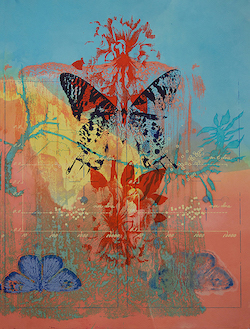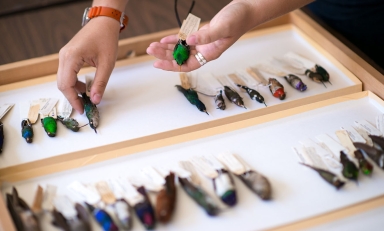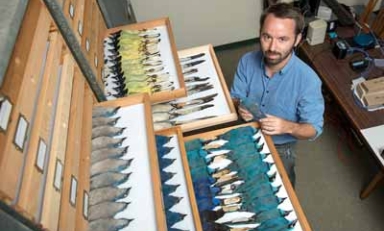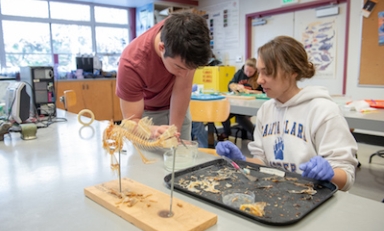
Printmaker Emily Arthur, whose installations and works on paper comment on environmental degradation and human rights, will be the subject of a one-person show titled "Emily Arthur—Endangered" in Occidental College’s Weingart Gallery March 2-April 9.
A public reception with the artist will be held March 23 from 5 to 8 p.m. in Weingart Gallery.
Curated by Nancy Marie Mithlo, associate professor of art history and visual arts and chair of American Indian Studies at the Autry Museum of the American West, the show will draw on Arthur’s exploration of Occidental’s natural history collections, notably the renowned Moore Laboratory of Zoology collection of birds—one of the world’s largest natural history research collections.
During a 2015 research trip to Occidental, Arthur, an assistant professor of art at the University of Wisconsin-Madison, was introduced to the controversy surrounding the California gnatcatcher, an endangered bird that lives in the California sage scrub zone, one of the state’s most threatened habitats.
Efforts are underway to have the gnatcatcher removed from the endangered species list, potentially opening up 197,000 acres of California coastline for development. Arthur’s exhibit, which includes large-scale screen prints based on specimens from the Moore Lab collection, a sound element by artist Jon Almaraz and a cast resin bird installation, seeks to focus attention on this critical environmental issue and educate the public about nature, culture and power.
Arthur’s research interests address narratives of loss, rebirth and transformation. Nature is seen as an interdependent living force, with land holding meaning specific to place. Native American narratives of dislocation, genocide and historic trauma are balanced with a fascination for the beauty of nature.
"In Arthur’s words, she ‘serves as witness to the cycles of destruction and creation inherent in the natural world,’" Mithlo wrote in the 2013 catalog Air, Land, Seed. "The act of making art, leaving a mark, keeps the balance; it holds in tension the beauty and the pain. Given Arthur’s interventionist agenda, it seems appropriate that birds are her favored motif for these acts of visual diplomacy. … These winged messengers call out to the viewer to take note. They carry wisdom and yet their very fragility and at times, obvious lifelessness, seem to suggest a darker side, an inability to withstand the weight of hostile urban decay.
"For Arthur, birds are symbols of the soul—they traverse from land to air, or water to air. They navigate impossible contradictions. In this way, we can ‘understand what is not understandable’ including death. This translation process is often fraught however, as the viewer instinctually averts death’s visceral finality."
Arthur’s weeklong Occidental residency will include a lecture at the March 23 exhibit opening; a collaborative print project with AHVA Professor Linda Lyke and students; a digital exhibit catalog to accompany the show designed and developed by Mithlo and students enrolled in her Culture of Collections course; and a March 25 nature hike at a Palos Verdes land reserve that includes gnatcatcher habitat.
Arthur received an MFA from the Pennsylvania Academy of the Fine Arts and has served as a Fellow at the Barnes Foundation for Advanced Theoretical and Critical Research in Pennsylvania. Additional education includes the Rhode Island School of Design and the Tamarind Institute of Lithography at the University of New Mexico.
Her work is included in the permanent collections of the Minneapolis Institute of Art, Cocker Art Museum in Sacramento, the Autry Museum of the American West, Museum of Contemporary Native Arts, Tweed Museum of Art, University of Minnesota Duluth, Leifur Eiriksson Foundation and the University of Virginia, as well as in international collections in Russia, Estonia, Japan, New Zealand, the United Kingdom, Italy and France.
"Emily Arthur—Endangered" is free and open to the public. Weingart Gallery, located on the Occidental campus in the Weingart Center for the Liberal Arts, is open Monday-Friday, 9 a.m.-5 p.m.
Arthur’s residency received funding from Occidental’s Center for Community Based Learning, the department of art history and visual arts, the cultural studies program, Moore Laboratory of Zoology, the Remsen Bird Fund and donor Loren G. Lipson, M.D.



